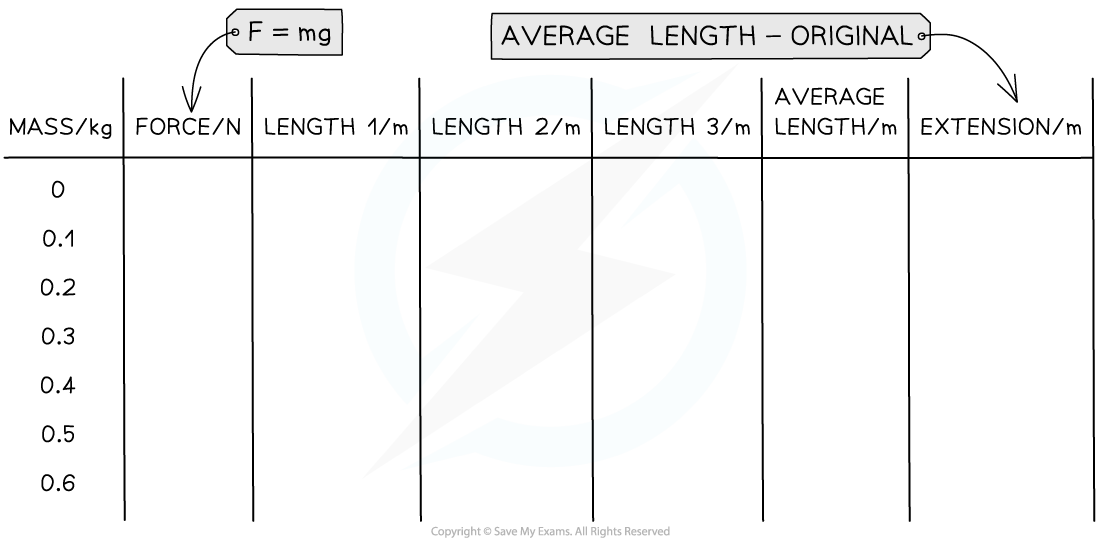PAG: Investigating Force & Extension (OCR GCSE Combined Science A (Gateway)) : Revision Note
PAG: Investigating Force & Extension
Aim of the Experiment
The aim of this experiment is to investigate the relationship between force and extension for a spring
Variables:
Independent variable = Force, F
Dependent variable = Extension, x
Control variables:
Spring constant, k
Equipment List

Resolution of measuring equipment:
Ruler = 1 mm
Method

Investigating Hooke's law apparatus
Set up the apparatus as shown in the diagram, initially without any masses hanging from the spring
Align the marker to a value on the ruler, record the initial length of the spring
Add the 100 g mass hanger onto the spring
Record the mass (in kg) and position (in cm) from the ruler now that the spring has extended
Add another 100 g to the mass hanger
Record the new mass and position from the ruler now that the spring has extended further
Repeat this process until all masses have been added
The masses are then removed and the entire process is repeated again until it has been carried out a total of three times, and an average length is calculated
An example table of results might look like this:

Analysis of Results
The force, F added to the spring is the weight of the mass
The weight is calculated using the equation:
W = mg
Where:
W = weight in newtons (N)
m = mass in kilograms (kg)
g = gravitational field strength on Earth in newtons per kg (N/kg)
Therefore, multiply each mass by gravitational field strength, g, to calculate the force, F
The force can be calculated by multiplying the mass (in kg) by g = 10 N/kg
The extension of the spring is calculated using the equation:
Final length – Original length
The final length is the length of the spring recorded from the ruler when the masses were added
The original length is the length of the spring when there were no masses
Plot a graph of the force against extension
Draw a line of best fit
If the graph has a linear region (is a straight line), then the force is proportional to the extension and the spring obeys Hooke's law for these forces and extension

Example force-extension graph for a spring that obeys Hooke's law
Evaluating the Experiment
Systematic Errors:
Make sure the measurements on the ruler are taken at eye level to avoid parallax error
Random Errors:
The accuracy of such an experiment is improved with the use of a pointer (a fiducial marker)

Fiducial marker to measure the extension more accurately
Wait a few seconds for the spring to fully extend when a mass is added, before taking the reading for its new length
Make sure to check whether the spring has not gone past its limit of proportionality otherwise, it has been stretched too far and will stop obeying Hooke's law
Safety Considerations
Wear goggles during this experiment in case the spring snaps
Stand up while carrying out the experiment making sure no feet are directly under the masses
Place a mat or a soft material below the masses to prevent any damage in case they fall
Use a G clamp to secure the clamp stand to the desk so that the clamp and masses do not fall over
As well as this, place each mass carefully on the hanger and do not pull the spring too hard that it breaks or pulls the apparatus over
Examiner Tips and Tricks
Remember - the extension measures how much the object has stretched by and can be found by subtracting the original length from each of the subsequent lengthsA common mistake is to calculate the increase in length by each time instead of the total extension – if each of your extensions is roughly the same then you might have made this mistake!

You've read 0 of your 5 free revision notes this week
Sign up now. It’s free!
Did this page help you?

